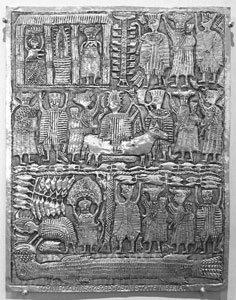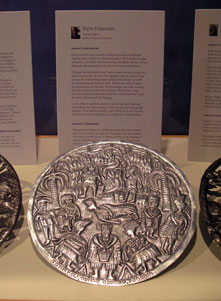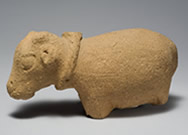The Art And Architecture Of Yorubaland! - Culture (4) - Nairaland
Nairaland Forum / Nairaland / General / Culture / The Art And Architecture Of Yorubaland! (128400 Views)
A Short History Of Yorubaland With Pictures / Art And Architecture Of The Igbo People / Benin Art And Architecture (2) (3) (4)
(1) (2) (3) (4) (5) (6) (7) (8) (9) (10) ... (16) (Reply) (Go Down)
| Re: The Art And Architecture Of Yorubaland! by PhysicsQED(m): 2:38pm On Oct 02, 2011 |
tpia@:    Calm down. Nobody could possibly claim Benin took precedence in Nigeria lost wax casting without evidence, and I have seen other Ife art that actually was radiocarbon dated, so that's not even the point. There's a Benin thread and I'm not interested in diluting this thread with material or information that I've already seen. I was just pointing out that that particular piece hadn't been dated to a specific time, so seeing something as specific as "12th century" as it's label doesn't make sense and is almost arbitrary. I only even mentioned Benin to admit that the same was true of many of the Benin pieces, which are also undated, other wise I wouldn't have mentioned Benin. The basis of the assigned dates for most of them both was basically Frank Willett and William Fagg's ideas about the artistic progression of certain styles over centuries; there were few radiocarbon dates. Calm down. Nobody could possibly claim Benin took precedence in Nigeria lost wax casting without evidence, and I have seen other Ife art that actually was radiocarbon dated, so that's not even the point. There's a Benin thread and I'm not interested in diluting this thread with material or information that I've already seen. I was just pointing out that that particular piece hadn't been dated to a specific time, so seeing something as specific as "12th century" as it's label doesn't make sense and is almost arbitrary. I only even mentioned Benin to admit that the same was true of many of the Benin pieces, which are also undated, other wise I wouldn't have mentioned Benin. The basis of the assigned dates for most of them both was basically Frank Willett and William Fagg's ideas about the artistic progression of certain styles over centuries; there were few radiocarbon dates. |
| Re: The Art And Architecture Of Yorubaland! by lakal(m): 3:48pm On Oct 02, 2011 |
PAGAN 9JA: Yes there still are. The Fakeye family is a multigenerational group of modern Yoruba sculptors. Lamidi Fakeye (1928-2009) carved the doors of the African Room at the Kennedy Center in Washington, D.C. Other prominent sculptors are Akin Fakeye (b. 1936) Azeez Kayode Fakeye (b. 1965) and Lukman Fakeye (B. 1983) 2 Likes |
| Re: The Art And Architecture Of Yorubaland! by lakal(m): 3:49pm On Oct 02, 2011 |
The doors of the African Room at the Kennedy Center In Washindgton, D.C.  |
| Re: The Art And Architecture Of Yorubaland! by lakal(m): 3:59pm On Oct 02, 2011 |
A major venue for the modern-day works of Yoruba artists to be displayed is the annual Osun Osogbo festival, held at the Osun Osogbo grove, a UNESCO world Heritage site. Artist's depiction of the "Arugba Osun" or maiden that leads the Osun festival's procession.  (Sidenote: Tunde Kelani of Mainframe Productions also made a movie entitled "Arugba"   1 Like |
| Re: The Art And Architecture Of Yorubaland! by lakal(m): 4:06pm On Oct 02, 2011 |
Artist Toyin Folorunso works in aluminum, using traditional Yoruba style:  Mr. Folorunso also designed the medal for former U.S. President Clinton's "Clinton Global Initiative."  2 Likes |
| Re: The Art And Architecture Of Yorubaland! by lakal(m): 4:52pm On Oct 02, 2011 |
| Re: The Art And Architecture Of Yorubaland! by lakal(m): 4:55pm On Oct 02, 2011 |
[img]http://hum.lss.wisc.edu/hjdrewal/Ife3.jpg[/img] Ife terracotta. Child of Obatala (creation divinity). The sculpture probably depicts a ritual specialist indicated by the bead on his forehead and the skull pendant. 2 Likes |
| Re: The Art And Architecture Of Yorubaland! by lakal(m): 5:04pm On Oct 02, 2011 |
 Quartz stool from shrine at Oluorogbo, Ife, Nigeria, now in British Museum, London, United Kingdom This also appears to be a stool? [img]http://hum.lss.wisc.edu/hjdrewal/ife_new_4_jthu.jpg[/img] |
| Re: The Art And Architecture Of Yorubaland! by lakal(m): 5:13pm On Oct 02, 2011 |
 Torso with beaded necklaces, Ife, Igbo Kubolaje. Terracotta, 12th-14th century.  Bracelet of birds pecking at bound humans, Ife, brass, 14th-15th century.  Ram figure, Osangangan Obamakin, Ife. Terracotta, 12th-15th century. |
| Re: The Art And Architecture Of Yorubaland! by lakal(m): 5:16pm On Oct 02, 2011 |
 African, Nigeria, Owo, Yoruba people Horse and Rider (Jagunjagun Eleshin), probably 17th-18th century, wood. A mounted warrior dressed in body armor and a large helmet sits straight up on his horse with his javelin poised to attack. The lines on his face exaggerate a terrible gaze that is intended to strike fear into the hearts of his foes. Based on this decoration we can determine that the invader is from the northern kingdom of Oyo in Yorubaland and is part of the force that invaded the southern Owo region in the seventeenth and eighteenth centuries. This piece was likely commissioned as an altarpiece dedicated to Ifa, the god of divination. The unknown sculptor uses intricate carving and zigzag patterns to create detail and character in the clothing, armor and tack on the horse and rider. The sculptural style indicates that it was created in the southern Owo region. Clearly the invaders from the north made a deep impression on the artist and the people who created this piece. |
| Re: The Art And Architecture Of Yorubaland! by lakal(m): 5:26pm On Oct 02, 2011 |
The following images come from the expedition of Leo Frobenius to Southern Nigeria in 1910-12. Frobenius is famous for ascribing an "Atlantean" origin to the Ife bronzes. Kabiyesi o!  |
| Re: The Art And Architecture Of Yorubaland! by lakal(m): 5:27pm On Oct 02, 2011 |
Palace under construction.  |
| Re: The Art And Architecture Of Yorubaland! by PhysicsQED(m): 5:33pm On Oct 02, 2011 |
lakal:       This is awesome! Have you found any other art representing Oyo cavalry? I had been looking for some and couldn't find any. |
| Re: The Art And Architecture Of Yorubaland! by lakal(m): 5:35pm On Oct 02, 2011 |
Traditional Yoruba house plan. The Yoruba house was centered around courtyards; most daily life and activities took place in the courtyard, with rooms reserved for sleeping. Courtyards had large jars for collecting rainwater, and had drainage to stop damage from excess water. [img]http://www.pitt.edu/~natrooms/africa/T3c_files/image002.gif[/img] |
| Re: The Art And Architecture Of Yorubaland! by lakal(m): 5:41pm On Oct 02, 2011 |
I iwsh they had pictures of the Olowo of Owo's palace, the largest palace in Africa. The largest courtyard in that palace is said to be twice the length of an American football field!  |
| Re: The Art And Architecture Of Yorubaland! by PhysicsQED(m): 5:44pm On Oct 02, 2011 |
@ lakal, I agree with you that thatch, when done well, is better than corrugated iron in appearance. I strongly dislike the look of corrugated iron on the roofs of some buildings in Nigeria. When I go back home and I see how the roofs of some of the traditional palaces of the different title holders look, I'm disappointed because I frequently see ugly corrugated iron. Of course, if the shape of the roof on a building is done creatively/artistically and the roof is painted well, like that Akaba Idena building in Ketu, then corrugated iron can still look good. |
| Re: The Art And Architecture Of Yorubaland! by PAGAN9JA(m): 5:52pm On Oct 02, 2011 |
lakal: ah its good to hear that. the Glods bless them. |
| Re: The Art And Architecture Of Yorubaland! by lakal(m): 6:00pm On Oct 02, 2011 |
PhysicsQED: Unfortunately, no! At least none that aren't extremely stylized. I'm still searching, however. You know there is one Benin bronze that is either said to represent a Yoruba horseman, or a warrior from Idah. That's another possibility. |
| Re: The Art And Architecture Of Yorubaland! by lakal(m): 6:18pm On Oct 02, 2011 |
 The unusual carving discussed here is of a bearded rider holding the reins in his left hand. He is wearing a short-sleeved tunic and breeches, his coiffure dressed as a long, interlaced pigtail falling to the horse's rump, with white painted eyes, and a sheathed broadsword at the left hip. The horse has a halter carved as rectangular-link chain, its legs clustered on the small, pierced, rectangular base, and painted spots on the saddle cloth. This figure takes the form of an Oyo-Yoruba cavalryman of the highest military grade. It may indeed be a representation of the alafin (king) of Oyo's commander-in-chief ("the esho of the eshos"  , of whom the Yoruba Samuel Johnson wrote a century ago in his The History of the Yorubas (C.M.S., Lagos, 1921; reprinted 1937). This supremo's office was created about the end of the seventeenth century when the might of Oyo was growing and winning the city prominence in the Atlantic trade. , of whom the Yoruba Samuel Johnson wrote a century ago in his The History of the Yorubas (C.M.S., Lagos, 1921; reprinted 1937). This supremo's office was created about the end of the seventeenth century when the might of Oyo was growing and winning the city prominence in the Atlantic trade.1 Like 1 Share |
| Re: The Art And Architecture Of Yorubaland! by PhysicsQED(m): 6:36pm On Oct 02, 2011 |
lakal: Yeah, I thought it represented the Attah of Idah earlier. J. Nevadomsky made a pretty convincing (to me) argument for it in his article on the horseman being the ruler of Idah, but I read another article (a 1993 article) from him published after that original article in which he corrects and changes his earlier theory and argues instead that there is strong evidence that the bronze horseman represents Oba Esigie of Benin. There are multiple horsemen figures, and not all are identical however, so it's still possible that it represents someone else. I really am kind of ecstatic to see that image you posted earlier though, because this whole time I had had to imagine what the Oyo horsemen looked like while reading about Oyo, and it was like a big, gaping hole in my knowledge that was just bothering me the whole time. A picture really is worth a thousand words. |
| Re: The Art And Architecture Of Yorubaland! by PhysicsQED(m): 6:46pm On Oct 02, 2011 |
Ah, actually I remember seeing that second horseman before. So I guess I had seen at least one Oyo horseman, actually. But that first horseman in the Owo sculpture is still just great, as far as giving us a good glance at what the military outfit of Oyo cavalrymen was like. That image should be a lot less obscure or hard to find than it is, considering how important it is. |
| Re: The Art And Architecture Of Yorubaland! by aljharem3: 6:49pm On Oct 02, 2011 |
yoruba horseman |
| Re: The Art And Architecture Of Yorubaland! by aljharem3: 6:49pm On Oct 02, 2011 |
| Re: The Art And Architecture Of Yorubaland! by aljharem3: 6:50pm On Oct 02, 2011 |
[img]http://t0.gstatic.com/images?q=tbn:ANd9GcSvuZaADCHro7iTdOtkiJiKrf7qDAL95b5CB21Pv_hmyo9NA00D[/img] oyo horseman |
| Re: The Art And Architecture Of Yorubaland! by aljharem3: 6:51pm On Oct 02, 2011 |
Ibegi Yoruba, Nigera |
| Re: The Art And Architecture Of Yorubaland! by aljharem3: 6:54pm On Oct 02, 2011 |
 A FINE YORUBA MALE TWIN FIGURE IN COWRY SHELL COAT A FINE YORUBA MALE TWIN FIGURE IN COWRY SHELL COAT Ere Ibeji, from the Igbomina area With carved triangular pendants on breast and back, black bead necklace, sandalled feet, dark glossy patina, the coat covered in shells |
| Re: The Art And Architecture Of Yorubaland! by aljharem3: 6:55pm On Oct 02, 2011 |
 Sopona (or Shapona) is the god of smallpox in the Yoruba religion. The Yoruba people of Nigeria believed that smallpox was a disease foisted upon humans due to Shapona's "divine displeasure", and formal worship of the God of Smallpox was highly controlled by specific priests in charge of shrines to the God. People believed that if the priests were angered they were capable of causing smallpox outbreaks through their intimate relationship with Shapona. Suspecting that the priests were deliberately spreading the disease, the British colonial rulers banned the worship of Shapona in 1907. Worship continued, however, with the faithful paying homage to the God even after such activities were prohibited. Shapona was exported to the New World in the slave trade, where he became known as Omolu or Babalu Aye in the Orisha religion. Shakpana is an equivalent in Dahomey mythology. |
| Re: The Art And Architecture Of Yorubaland! by aljharem3: 6:57pm On Oct 02, 2011 |
. |
| Re: The Art And Architecture Of Yorubaland! by lakal(m): 7:36pm On Oct 02, 2011 |
Epa Mask, Ekiti Region. Mounted Horseman (jagunjagun) [img]http://t1.gstatic.com/images?q=tbn:ANd9GcS0BOQXjINJIIDj5kjqx4BFOTXgkOfqqWsvy9WqWdMo-UCs1j5vfLy3tfDfZA[/img] |
| Re: The Art And Architecture Of Yorubaland! by Nobody: 7:38pm On Oct 02, 2011 |
lakal: Orobokibo to kibo. Wow. @Post Ekiti Jagunlabi, good job jare. I was going to make a thread like this but it totally skipped my mind. |
| Re: The Art And Architecture Of Yorubaland! by lakal(m): 7:38pm On Oct 02, 2011 |
Part of an Oba's royal attire: fully beaded footwear (19th Century).  Beaded slippers were part of the regalia worn by the Yoruba king (oba) when he appeared in public ceremonies. Beaded shoes became popular in the eighteenth or nineteenth centuries when European fashion became the model for prestige wear and Yoruba leaders began to move freely outside of the palace. Rulers created laws prohibiting commoners from wearing shoes and other items associated with royalty. When the king is greeted in Yoruba society, people say, “May the crown rest long on your head, may shoes remain long on your feet.” |
| Re: The Art And Architecture Of Yorubaland! by PhysicsQED(m): 7:44pm On Oct 02, 2011 |
 Veranda Post: Equestrian Figure and Female Caryatid Olowe of Ise (Nigerian, born Ise, about 1873–1938) Date: before 1938 Geography: Nigeria, Yorubaland, Efon-Alaiye region Culture: Yoruba peoples, Ekiti group Medium: Wood, pigment Dimensions: H. 71 x W. 11 1/4 x D. 14 in. (180.3 x 28.6 x 35.6 cm) Classification: Wood-Architectural Credit Line: Purchase, Lila Acheson Wallace Gift, 1996 Accession Number: 1996.558 This monumental work was one of a series of carved architectural supports designed for the exterior courtyard of a Yoruba palace. It was commissioned by a king from the most renowned master sculptor in the history of Yoruba art, Olowe of Ise. The two-tiered composition embodies a formal dynamism that established Olowe's exceptional artistic reputation. Its principal personage, an equestrian warior, is depicted frontally above a female caryatid with arms raised in three-quarter view. Through this contrast in their alignment, the figures at once reflect distinct attitudes while relating to each other fluidly. The compressed style of the upper half also contrasts with the greater degree of openness below. At the base two smaller figures radiate outward at oblique angles. In addition to the inventive dynamism of their overall design, works by Olowe are noted for the attention given to surface detail. The mounted warrior holds a spear and pistol in either hand, and his vest, saddle, and horse's headgear are articulated through deeply carved linear motifs. While innovative in its formal interpretation, the subject of this work is a classic emblem of regional leadership. In Yoruba art such equestrian figures identify their patrons with martial conquest achieved through physical might. |
(1) (2) (3) (4) (5) (6) (7) (8) (9) (10) ... (16) (Reply)
Traditional Eastern Ijaw Attire In Pictures / The True Extent Of Alaigbo (Igboland) / 18+ Unclad Photos Of African Women Slaves From The Past.
(Go Up)
| Sections: politics (1) business autos (1) jobs (1) career education (1) romance computers phones travel sports fashion health religion celebs tv-movies music-radio literature webmasters programming techmarket Links: (1) (2) (3) (4) (5) (6) (7) (8) (9) (10) Nairaland - Copyright © 2005 - 2024 Oluwaseun Osewa. All rights reserved. See How To Advertise. 60 |

